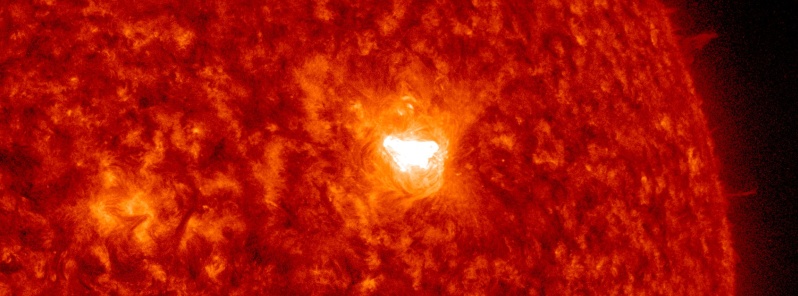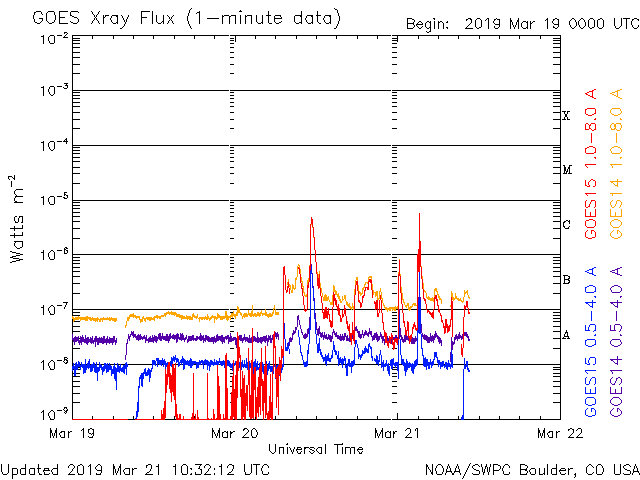Impulsive C5.6 solar flare erupts from AR 2736, source of yesterday’s full-halo CME

An impulsive solar flare measuring C5.6 at its peak time erupted from AR 2736, the source of yesterday's C4.8 and associated asymmetric full-halo CME, at 03:12 UTC on March 21, 2019. The event started at 03:08 and ended at 03:15 UTC.
There were no radio signatures that would suggest a Coronal Mass Ejection (CME) was produced by the event.



The region produced B8.0 at 00:13 and C1.2 at 02:52 UTC today. On March 20, AR 2736 produced C4.8 at 11:18 UTC, B1.0 at 13:09, B1.0 at 13:43, B2.1 at 14:32, B3.2 at 17:59 and B1.8 at 21:24 UTC.




Another faint, slow-moving CME occurred off the West limb at approximately 19:30 UTC on March 20 and will be analyzed and modeled as more coronagraph imagery becomes available.
Multiple ENLIL model runs seem to have reached a consensus that the arrival of the March 20 CME will occur around mid-UTC day on March 23. However, forecaster confidence is only at moderate levels with the arrival timing output due to over forecasted wind speeds in the current ambient environment, SWPC forecasters said 12:30 UTC, March 21.
Solar activity is expected to continue at low levels over the next three days. Region 2736 remains an active spot group. C-flares are likely the next three days with a slight chance of M-flares (R1-R2 (Minor-Moderate) radio blackouts).
The greater than 2 MeV electron flux was at moderate levels over the past 24 hours and is expected to be at normal to moderate levels over the next three days. The greater
than 10 MeV proton flux remains at background levels, but will largely depend on activity associated with Region 2736 in the days ahead.
Solar wind parameters were somewhat elevated over the past 24 hours due to a positive polarity CH HSS. Total field strength remained less than 5 nT, and the Bz component underwent no significant southward deviations. Phi was in a positive orientation.
Mostly quiet geomagnetic field conditions are expected on March 21 and 22 with a return to background solar wind conditions. G1-G2 (Minor-Moderate) geomagnetic storm conditions are likely on March 23 due to the anticipated arrival of the March 20 CME.
Featured image credit: NASA SDO/AIA 304

Commenting rules and guidelines
We value the thoughts and opinions of our readers and welcome healthy discussions on our website. In order to maintain a respectful and positive community, we ask that all commenters follow these rules:
We reserve the right to remove any comments that violate these rules. By commenting on our website, you agree to abide by these guidelines. Thank you for helping to create a positive and welcoming environment for all.